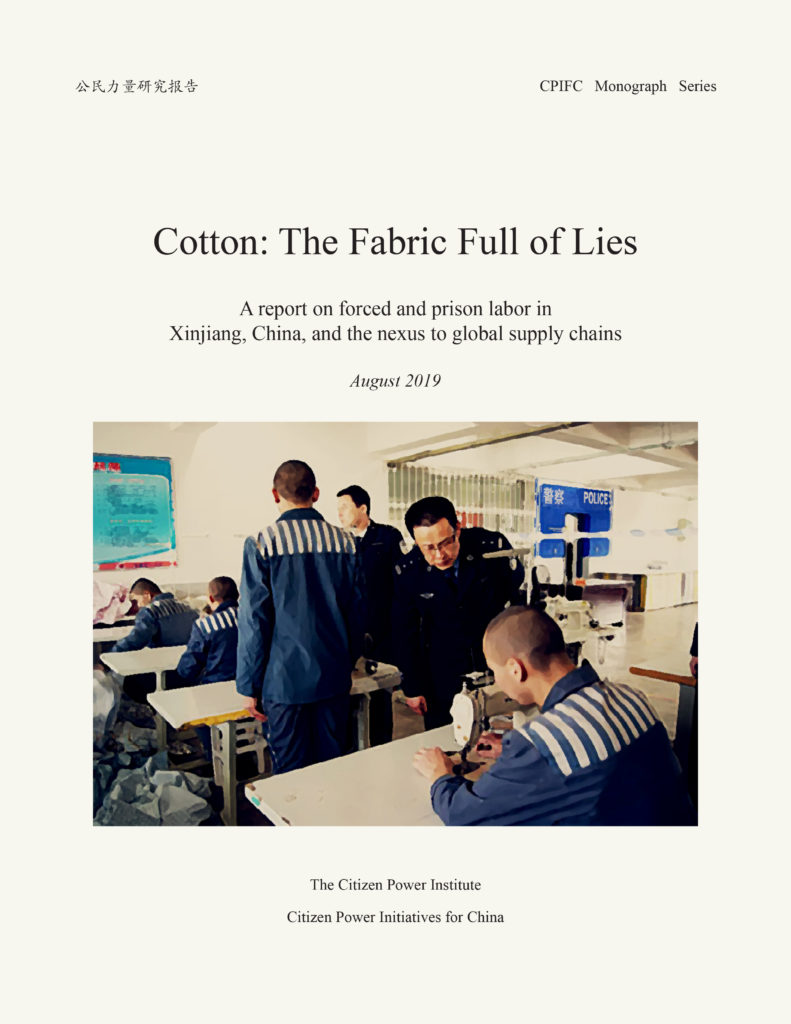A report on forced and prison labor in Xinjiang, China, and the nexus to global supply chains

Get Full Report
For government agencies and congressional offices
Please contact us to obtain a free copy of the report.
For the general public
Please obtain the report from Amazon link below:https://www.amazon.com/Cotton-Fabric-report-Xinjiang-Monograph-ebook/dp/B07VSJHNGZ
Executive Summary
China has created a “cotton gulag” in the Xinjiang Uyghur Autonomous Region (XUAR). Xinjiang produces 84 percent of China’s cotton output, and is a primary supplier and exporter of cotton/textile/apparel products. Xinjiang is also home to a large percentage of China’s prison population and these inmates serve as a key labor force in every link of China’s cotton value chain, from cotton field reclamation to planting, harvesting, processing, and garment production.
Direct evidence from data published by the Chinese Communist Party (CCP), Chinese companies, and witness testimonies shows that prisons in the region are forcing inmates to work in prison cotton farms, processing plants, and textile/garment factories. This prison-based economy is designed to meet two CCP goals: earn money for the State and “politically stabilize” Xinjiang. To conceal this practice, prison and labor camp authorities in Xinjiang have deleted online information regarding these prison companies and factories, changed the names of prison factories, and created layers of complex company ownership structures in order to disguise prison factories and farms as schools and trading companies.
Key Conclusions of the Report
- Xinjiang produces 84 percent of China’s cotton output, and is a primary supplier and exporter of cotton/textile/apparel products to Chinese factories in the interior of China, as well as internationally. The Xinjiang region has the largest number of prisons and labor camps in China, and it is China’s long-standing policy to use prison inmates as forced labor;
- Prison inmates in Xinjiang are routinely used to reclaim land for cotton fields, and participate in other parts of the cotton value chain, up to and including work in garment factories.
- In 2014, the Chinese Government began to implement a strategy to maintain political stability in Xinjiang. Part of the strategy involves the detention of large numbers of Uighurs in “re-education camps.” Concurrently, the government encouraged the development of the vertical integration of China’s garment manufacturing sector by moving textile and garment factories closer to cotton production in Xinjiang where Uighers could be placed for employment in the cotton/textile/garment industry;
- The presence of forced labor, particularly prison labor, at many steps of the cotton supply chain means that potentially all cotton/textile/apparel products from Xinjiang are produced with forced labor, and some of these products have entered into international commerce, including the U.S. and European markets.
The XUAR has a disproportionately high concentration of prisons in comparison with the other provinces in the country. Excluding Uyghur re-education camps, there are over 70 prisons in the XUAR compared to a mere 25 in Shandong Province despite the latter having a population over four times larger. This absurd ratio underscores a system of ethnic disenfranchisement initiated by the CCP that, while being propagated as a supposed means of re-education for criminals, functions as a way to inhumanely punish inmates, eradicate the Muslim faith in China, and provide a renewable source of unethical but cheap forced labor for the cotton and textile industry. Though the exact figure is unknown, we estimate there are half a million to 800,000 prisoners incarcerated in Xinjiang and forced to work in prison enterprises in many industry sectors. In addition, a million Uighurs are held in the “reeducation camps,” and many are forced to work under the new textile/apparel expansion plan.
Because forced labor is used so ubiquitously throughout Xinjiang, it is very difficult to separate Xinjiang’s forced labor economy from its regular economy. Based on our findings, governments, companies, and consumers should assume that any cotton products sourced from China are a product of China’s cotton gulag.
